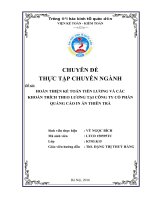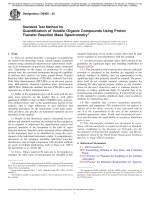Abstract for USAEE Meeting in September 2018
Bạn đang xem bản rút gọn của tài liệu. Xem và tải ngay bản đầy đủ của tài liệu tại đây (59.69 KB, 3 trang )
THE IMPACT OF EPA REGULATION AND U.S. SUPREME COURT OVERSIGHT ON
THE SHAREHOLDERS OF U.S. UTILITIES UTILIZING COAL
Kirk Philipich
University of Michigan – Dearborn
313-593-4731
Overview
It has been suggested that detrimental product market competition effects due to environmental regulations must
be considered in order not to overstate the net benefits accruing from environmental regulations (e.g. Heyes
2009). The industry/portfolio effects of new legislative actions have been estimated previously (Gilligan et al
1988) as have the effects of new regulations issued by regulatory agencies (Hughes et al 1986). With regards to
the EPA, the vast majority of previous market-based research has focused on individual firm effects due to
violations. In contrast, the current study attempts to determine any industry/portfolio effects due to the issuance
of new regulations and to any subsequent legal efforts challenging these new regulations.
Methods
The analysis employs the traditional “event study” approach. Four specific events are examined for an impact on
the shareholders of U.S. electricity providers/generators that employ(ed) coal to varying degrees: (1) the EPA’s
public release for comment of the initial or draft version of the eventual Clean Power Plan, June 2, 2014, (2) the
public release by the EPA of the final version of the Clean Power Plan’s regulations, August 3, 2015, (3) the U.S.
Supreme Court’s ruling that the EPA had “over-reached” in applying the Clean Air Act as a basis for its attempt
to limit the amount of green-house gas that could be released by industrial and electricity producing facilities,
June 29, 2015, and (4) the U.S. Supreme Court’s ruling suspending the implementation of the Clean Power Plan
until such time that various aspects of the Clean Power Plan had been litigated in the lower courts, February 9,
2016.
Initially, the traditional market model was to be augmented with the daily percentage change in spot natural gas
prices because natural gas is, to a large degree, the fossil fuel of choice as a substitute for coal by U.S. utilities.
However, due to “thin trading” a large number of “zero price changes” exist within the daily series of spot
natural gas prices. Its estimated coefficient could easily be “truncated” toward zero, and, in turn, could lead to
failing to reject this variable as having no relation to U.S. utilities’ stock returns. Thus, an additional explanatory
variable that may be correlated with percentage change in natural gas spot prices, the percentage change in crude
oil spot prices, is also incorporated into the market model. The following is the resulting augmented market
model:
R Pt = αP + βPRMt + βNGNGt + βCOCOt + εt
where:
R Pt = the daily return on an equally-weighted portfolio of electric providers/generators,
R Mt = the daily return on the value-weighted CRSP index,
NGt = the daily percentage change in the spot price for natural gas, and
COt = the daily percentage change in the spot price for crude oil.
(1)
Because the market was expecting these events to occur, but was completely unaware of their exact timing or
release, the market likely could not anticipate their release. Thus, in order to provide for as powerful a test as
possible and to reduce the impact of other unrelated events, only the day of the release (day 0) and the following
day (day +1) are examined for any anticipated market reaction to these events. Therefore, eight dummy variables
are included, two individual days for four separate events, as follows:
R Pt = αP + βPRMt + βNGNGt + βCOCOt + βD,0DD,0 + βD,1DD,1 + βF,0DF,0 + βF,1DF,1
+ βM,0DM,0 + βM,1DM,1 + βCP,0DCP,0 + βCP,1DCP,1 + εt
(2)
where:
DD = two separate dummy variables equal to “1” for the day of (day 0) and the day following (day +1) the release
of
the draft version of the Clean Power Plan, and “0” otherwise,
DF = two separate dummy variables equal to “1” for the day of (day 0) and the day following (day +1) the release
of
the final version of the Clean Power Plan, and “0” otherwise,
DM = two separate dummy variables equal to “1” for the day of (day 0) and the day following (day +1) the U.S.
Supreme Court’s issuance of its ruling that the EPA had over-reached in its application of the Clean Air
Act, and “0” otherwise, and
DCP = two separate dummy variables equal to “1” for the day of (day 0) and the day following (day +1) the U.S.
Supreme Court’s issuance of its ruling that various aspects of the Clean Power Plan must be litigated in
the
lower courts, and “0” otherwise.
Equation (2) is estimated using daily data for the time period January 2, 2014, through March 31, 2016 using
various portfolios: (1) both equally-weighted and value-weighted portfolios of a sample of U.S. electricity
generators that employ(ed) coal during the time period, forty-two in total, and (2) an equally-weighted portfolio
of a sample of international electricity generators, fifteen in total.
Results
The equation (2) estimation with the forty-two firm equally-weighted portfolio revealed: (1) a positive (0.6696)
and significant (α = .01 level) βp coefficient, (2) the coefficient for the day following the release of the final
version of the Clean Power Plan, βF,1, being significant (α = .05 level) and negative (-0.0185), and (3) the
coefficient for the day of the release of the U.S. Supreme Court’s ruling that the EPA had over-reached in its
usage of the Clean Air Act, βM,0, being significant (α = .05 level) and positive (0.0172). Next, as a comparison,
equation (2) is estimated with the equally-weighted portfolio of international firms that provide/generate
electricity. None of the events elicted significant market reactions from this portfolio of firms operating outside
the auspices of the EPA.
As an additional check, the forty-two U.S. firms were used to form a value-weighted portfolio which was then
used to estimate equation (2) leading to: (1) a significant (α = .01 level) and positive (0.0142) βp coefficient, and
(2) the coefficient for the day following the release of the final version of the Clean Power Plan, βF,1, is found to
be be significant (α = .05 level) and negative (-0.0004). However, the coefficient for the day of the release of the
U.S. Supreme Court’s ruling that the EPA had over-reached in its application of the Clean Air Act, βM,0, is now
insignificant. This perhaps indicates that the size of the firms in the portfolio had an impact.
Thus, the sample of forty-two U.S. firms was split on the basis of size (market capitalization) into two separate
twenty-one firm samples and subsequently equally-weighted portfolios. The small-firm portfolio’s equation (2)
estimation revealed: (1) a significant (α = .01 level) and positive (0.7082) βp coefficient, (2) the coefficient for
the day following the release of the final version of the Clean Power Plan, βF,1, being significant (α = .05 level)
and negative (-0.0176), and (3) the coefficient for the day of the release of the U.S. Supreme Court’s ruling that
the EPA had over-reached in its application of the Clean Air Act, βM,0, being significant (α = .05 level) and
positive (0.0313). The large-firm portfolio’s equation (2) estimation only revealed: (1) a significant (α = .01
level) and positive (0.6310) βp coefficient, and (2) the coefficient for the day following the release of the final
version of the Clean Power Plan, βF,1, being significant (α = .05 level) and negative (-0.0195).
Conclusions
The fact that all four estimations incorporating a portfolio of U.S. utilities, either all forty-two U.S. utilities or its
two twenty-one firm subsets, reveal significant (α = .05 level) and negative βF,1 coefficients yields strong support
to the notion that shareholders of U.S. utilities that employ(ed) coal were all injured by the EPA’s attempt to
further reduce their use of coal. This is further supported by the fact that all three estimations incorporating
equally-weighted portfolios yield nearly identical estimated values for the βF,1 coefficient. In contrast, while the
equally-weighted forty-two firm portfolio appears to indicate that ALL shareholders of ALL of these firms
potentially benefited from the Supreme Court’s ruling, further analysis, the use of two twenty-one firm sizebased portfolios, indicates that this benefit was only realized by the shareholders of the smallest U.S. utilities.
This is possibly due to less being known about the smaller firms and so any new information that could have
value implications leads to stronger market reactions for the smaller firms than for the larger U.S. utilities that
operate and/or have their securities traded in a more information-rich environment.
References
Gilligan, Thomas W. and Keith Krehbiel. (1988). “Complex Rules and Congressional Outcomes: An Event Study
of Energy Tax Legislation,” The Journal of Politics 50(3): 625-654.
Heyes, Anthony. (2009). “Is environmental regulation bad for competition? A survey,” Journal of Regulatory
Economics 36: 1-28.
Hughes, John S., Wesley A. Magat and William E. Ricks. (1986). “The Economic Consequences of the OSHA
Cotton Dust Standards: An Analysis of Stock Price Behavior,” The Journal of Law & Economics 29(1): 2959.









